From Wikipedia, the free encyclopedia
(Redirected from WC-135 Constant Phoenix)
| WC-135 Constant Phoenix | |
|---|---|
 |
|
| A WC-135 Constant Phoenix approaching a tanker | |
| Role | Atmosphere Testing Related to Nuclear Incidents |
| Manufacturer | Boeing Military Airplanes Division |
| Introduction | December 1965 |
| Primary user | United States Air Force |
| Number built | 10 original WC-135B, plus 1 converted former EC-135C (2 still in service) |
| Developed from | C-135 Stratolifter |
| Variants | OC-135B Open Skies |
Contents
Mission
The WC-135C and WC-135W Constant Phoenix atmospheric collection aircraft support national level intelligence consumers by collecting particulate debris and gaseous effluents from accessible regions of the atmosphere in support of the Limited Nuclear Test Ban Treaty of 1963.Features
The WC-135W (tail number 61-2667) is a modified C-135B. The WC-135C (tail number 62-3582) is an extensively modified former EC-135C Looking Glass aircraft. The Constant Phoenix’s modifications are primarily related to the aircraft's on-board atmospheric collection suite, which allows the mission crew to detect radioactive debris "clouds" in real time. The aircraft is equipped with external flow-through devices to collect particulates on filter paper and a compressor system for whole air samples collected in high-pressure holding spheres.The interior seats 33 people, including the cockpit crew, maintenance personnel, and special equipment operators from the Air Force Technical Applications Center. On operational sorties, the crew is minimized to just pilots, navigator, and special equipment operators, to reduce radiation exposure to mission-essential personnel only.
Vela Incident
WC-135B aircraft flew 25 sorties in 1979 to try to ascertain if a double flash in the south Atlantic that was detected by a Vela satellite was a nuclear weapons test,[1] however the result was inconclusive.Pakistan & India
The Constant Phoenix aircraft was used to gather information on the nuclear tests conducted by Pakistan and India in 1998.North Korea
On Friday 6 October 2006 Japan's Kyodo News agency reported that a US military aircraft, equipped to detect radiation from a nuclear test, took off from southern Japan. This was believed to be part of US efforts to prepare to monitor a North Korean nuclear test.On Monday 9 October 2006 North Korea's official Korean Central News Agency (KCNA) reported that the country had performed a successful underground nuclear test.
On October 13, 2006 CNN reported: "The U.S. Air Force flew a WC-135 Constant Phoenix atmospheric collection aircraft on Tuesday to collect air samples from the region. A preliminary analysis of air samples from North Korea shows "radioactive debris consistent with a North Korea nuclear test," according to a statement from the office of the top U.S. intelligence official. The statement, from the office of Director of National Intelligence John Negroponte, was sent to Capitol Hill but not released publicly. CNN obtained it from a congressional source. The national intelligence office statement said the air samples were collected Wednesday, and analysis found debris that would be consistent with a nuclear test "in the vicinity of Punggye" on Monday. The South Korean Defense Ministry told CNN that the United States has informed it that radioactivity has been detected." The aircraft was based at Offutt AFB, and was sent to Kadena AB on Okinawa to operate during the sampling missions.[2]
On June 17, 2009 JoongAng Daily reported, in reference to a purported May 25 nuclear test by North Korea: "The U.S. Air Force twice dispatched a special reconnaissance jet, the WC-135 Constant Phoenix from Kadena Air Base in Okinawa, Japan, to collect air samples." [3]
On November 23, 2010 Sankei Shimbun reported that a WC-135 had been moved to Kadena Air Base in September 2010, in anticipation of a North Korean nuclear test.[4]
On January 31, 2013 the WC-135W was reported to be conducting surveillance flights out of Kadena Air Base in anticipation of another North Korean nuclear test.[5]
Japan
On March 17, 2011 CNN reported WC-135W had been deployed from Offutt Air Force Base to assist in detecting radioactive materials in the atmosphere around Japan, monitoring radiation released from the Fukushima I Nuclear Power Plant caused by the magnitude 9.0 earthquake and subsequent tsunami of March 11, 2011.[6][7] the aircraft have been assigned to Eielson Air Force Base temporarily.[8] [9]Specifications
General characteristics- Crew: varies with mission
- Length: 139 ft 11 in (42.6 m)
- Wingspan: 130 ft 10 in (39.9 m)
- Height: 42 ft (12.8 m)
- Wing area: 2,433 ft² (226 m²)
- Max. takeoff weight: 300,500 lb (136,300 kg)
- Powerplant: 4 × Pratt & Whitney TF33-P-9 turbofan with thrust reversers, 16,050 lbf (71.4 kN) each
- Maximum speed: 350 knots (648 km/h)
- Range: 4000 miles (6437 km)
- Service ceiling: 40,000 ft (12,200 m)
- Wing loading: 123.5 lb/ft² (603 kg/m²)
- Thrust/weight: 0.21
- None
See also
- Related development
- Aircraft of comparable role, configuration and era
No comments:
Post a Comment